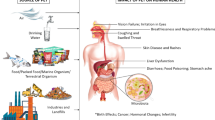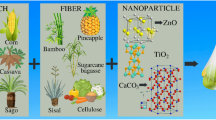Abstract
Frequently used pre-emergent herbicide metazachlor was encapsulated into high molecular weight poly(lactic acid) particles, and its subsequent release and the effectivity of such formulations were investigated. Two sets of polymeric micro- and submicro particles, both with the theoretical metazachlor loading of 20%, 30%, and 40%, were prepared and characterized. Loading efficiency reached 80% for both types of particles. Release profiles were tested in vitro for the individual particle variants and were shown to have a bimodal profile with the initial fast burst release and much slower second phase. Finally, selected formulations were tested in vivo against target plants (field poppy and barnyard grass) and non-targets plants (mustard and rapeseed) and showed improved inhibition of target plants (about 30% higher for barnyard grass) and at the same time lower inhibition of non-target plants (rapeseed) in comparison with the identical dose of metazachlor alone.





Similar content being viewed by others
References
Asrar J, Ding Y, La Monica R-E et al (2004) Controlled release of tebuconazole from a polymer matrix microparticle: release kinetics and length of efficacy. J Agric Food Chem 52(15):4814–4820
Castro M-J-L, Ojeda C, Cirelli A-F (2014) Advances in surfactants for agrochemicals. Environ Chem Lett 12(1):85–95
Chaara D, Bruna F, Ulibarri M-A et al (2011) Organo/layered double hydroxide nanohybrids used to remove non ionic pesticides. J Hazard Mater 196:350–359
Chowdhury M-A (2014) The controlled release of bioactive compounds from lignin and lignin-based biopolymer matrices. Int J Biol Macromol 65:136–147
Chowdhury M-A, Hill D, Whittaker A-K (2005) NMR imaging of the diffusion of water at 310 K into poly[(2-hydroxyethyl methacrylate)-co-(tetrahydrofurfuryl methacrylate)] containing vitamin B12 or aspirin. Polym Int 54:267–273
Dailey O-D (2004) Volatilization of alachlor from polymeric formulations. J Agric Food Chem 52(22):6742–6746
Feng J, Yang G, Zhang S et al (2018) Fabrication and characterization of β-cypermethrin-loaded PLA microcapsules prepared by emulsion-solvent evaporation: loading and release properties. Environ Sci Pollut Res Int 25(14):13525–13535
Ghormade V, Deshpande M-V, Paknikar K-M (2011) Perspectives for nano-biotechnology enabled protection and nutrition of plants. Biotechnol Adv 29(6):792–803
Greco A, Ferrari F, Maffezzoli A (2019) Mechanical properties of poly(lactid acid) plasticized by cardanol derivatives. Polym Degrad Stab 159:199–204
Grillo R, Pereira A, de Melo N et al (2011) Controlled release system for ametryn using polymer microspheres: preparation, characterization and release kinetics in water. J Hazard Mater 186(2–3):1645–1651
Guan H-N, Chi D-F, Yu J et al (2011) Novel photodegradable insecticide W/TiO2/avermectin nanocomposites obtained by polyelectrolytes assembly. Coll Surf B Biointerfaces 83(1):148–154
Kah M, Hofmann T (2014) Nanopesticide research: current trends and future priorities. Environ Int 63:224–235
Kashyap P-L, Xiang X, Heiden P (2015) Chitosan nanoparticle based delivery systems for sustainable agriculture. Int J Biol Macromol 77:36–51
Kočí V, Mocová K, Kulovaná M (2010) Phytotoxicity tests of solid wastes and contaminated soil in the Czech republic. Environ Sci Pollut Res 17(3):611–623
Kucharczyk P, Pavelková A, Stloukal P et. al (2013) Preparation of nanoparticles based on biodegradable chain linked PLA/PEG polymer for controlled release of herbicides metazachlor. NanoCon 2013. pp 448–452
Kumar S, Chauhan N, Gopal M et al (2015) Development and evaluation of alginate–chitosan nanocapsules for controlled release of acetamiprid. Int J Biol Macromol 81:631–637
Kwiecien I, Adamus G, Jiang G et al (2018) Biodegradable PBAT/PLA blend with bioactive MCPA-PHBV conjugate suppresses weed growth. Biomacromolecules 19(2):511–520
Li Z, Xu S, Wen L et al (2006) Controlled release of avermectin from porous hollow silica nanoparticles: influence of shell thickness on loading efficiency, UV-shielding property and release. J Controll Release 111(1–2):81–88
Liang J, Tang S, Cheke R-A et al (2015) Models for determining how many natural enemies to release inoculatively in combinations of biological and chemical control with pesticide resistance. J Math Anal Appl 422(2):1479–1503
Lim L-T, Auras R, Rubino M (2008) Processing technologies for poly(lactic acid). Prog Polym Sci 33(8):820–852
Liu B, Wang Y, Yang F et al (2016) Construction of a controlled-release delivery system for pesticides using biodegradable PLA-based microcapsules. Coll Surf B Biointerfaces 144:38–45
Liu B, Wang Y, Yang F et al (2018) Development of a chlorantraniliprole microcapsule formulation with a high loading content and controlled-release property. J Agric Food Chem 66(26):6561–6568
Mohr S, Berghahn R, Feibicke M et al (2007) Effects of the herbicide metazachlor on macrophytes and ecosystem function in freshwater pond and stream mesocosms. Aquat Toxicol 82(2):73–84
Montoro E-P, González R-R, Frenich A-G et al (2007) Fast determination of herbicides in waters by ultra-performance liquid chromatography/tandem mass spectrometry. Rapid Commun Mass Spectrom 21:3585–3592
Roy A, Singh S-K, Bajpai J et al (2014) Controlled pesticide release from biodegradable polymers. Cent Eur J Chem 12(4):453–469
Saeidlou S, Huneault M-A, Li H et al (2012) Poly(lactic acid) crystallization. Prog Polym Sc. 37:1657–1677
Sharp J-S, Forrest J-A, Jones R-A-L (2001) Swelling of poly(DL-lactide) and polylactide-co-glycolide in humin environments. Macromolecules 34(25):8752–8760
Siepmann J, Peppas N-A (2001) Modeling of drug release from delivery systems based on hydroxypropyl methylcellulose (HPMC). Adv Drug Deliv Rev 48(2–3):139–157
Stloukal P, Kucharczyk P, Sedlarik V et al (2012a) Low molecular weight poly(lactic acid) microparticles for controlled release of the herbicide metazachlor: preparation, morphology, and release kinetics. J Agric Food Chem 60:4111
Stloukal P, Verney V, Commereuc S et al (2012b) Assessment of the interrelation between photooxidation and biodegradation of selected polyesters after artificial weathering. Chemosphere 88(10):1214–1219
Takei T, Yoshida M, Hatate Y et al (2008) Preparation of polylactide- base microspheres enclosing acetamiprid and evaluation of efficacy against cotton aphid by soil application. J Appl Polym Sci 109:763–766
Taki S, Badens E, Charbit G (2001) Controlled release system formed by supercritical anti-solvent coprecipitation of a herbicide and a biodegradable polymer. J Supercrit Fluids 21(1):61–70
Tsuji K (2008) Microencapsulation of pesticides and their improved handling safety. J Microencapsul 18(2):137–147
Włodarczyk M (2014) Influence of formulation on mobility of metazachlor in soil. Environ Monit Assess 186(6):3503–3509
Xiao H, Lu W, Yeh J-T-J (2009) Effect of plasticizer on the crystallization behavior of poly(lactic acid). J Appl Polym Sci 113(1):112–121
Yu M, Yao J, Liang J et al (2017) Development of functionalized abamectin poly(lactic acid) nanoparticles with regulatable adhesion to enhance foliar retention. RSC Adv 7:11271–11280
Yusoff S-N-M, Kamari A, Aljafree N-F-A (2016) A review of materials used as carrier agents in pesticide formulations. Int J Environ Sci Te 13(12):2977–2994
Zhao J, Wilkins R-M (2005) Low molecular weight polylactic acid as a metric for the delayed release of pesticides. J Agric Food Chem 53(10):4076–4082
Zuleger S, Lippold B-C (2001) Polymer particle erosion controlling drug release. I. factors influencing drug release and characterization of the release mechanism. Int J Pharm 217(1–2):139–152
Acknowledgements
Financial support from Tomas Bata University in Zlín, Internal Grant Agencies (Project IGA/FT/2018/009 and IGA/FT/2019/011) was gratefully acknowledged.
Author information
Authors and Affiliations
Corresponding author
Additional information
Editorial responsibility: M. Abbaspour.
Rights and permissions
About this article
Cite this article
Salač, J., Šopík, T., Stloukal, P. et al. Slow release formulation of herbicide metazachlor based on high molecular weight poly(lactic acid) submicro and microparticles. Int. J. Environ. Sci. Technol. 16, 6135–6144 (2019). https://doi.org/10.1007/s13762-019-02222-9
Received:
Revised:
Accepted:
Published:
Issue Date:
DOI: https://doi.org/10.1007/s13762-019-02222-9




